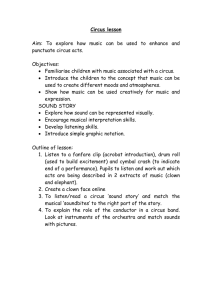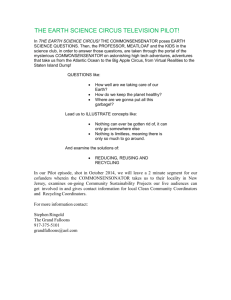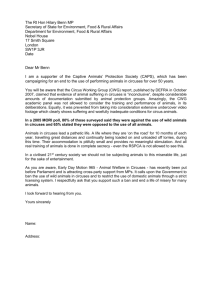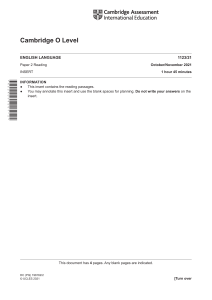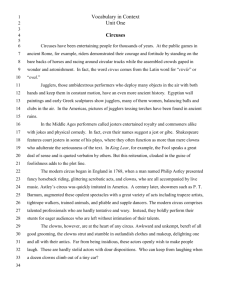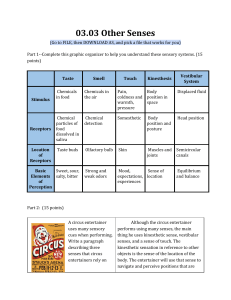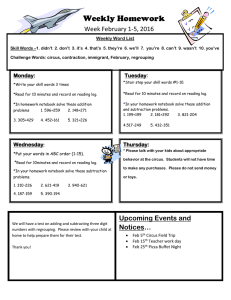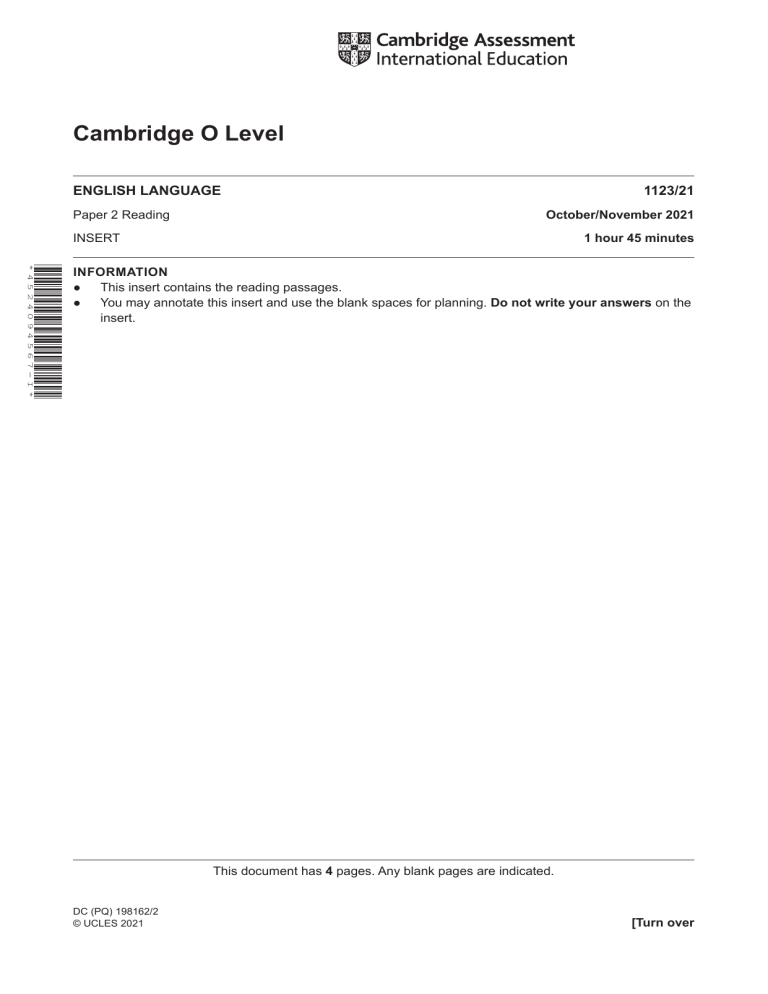
Cambridge O Level ENGLISH LANGUAGE Paper 2 Reading 1123/21 October/November 2021 1 hour 45 minutes INSERT *4524094567-I* INFORMATION ● This insert contains the reading passages. ● You may annotate this insert and use the blank spaces for planning. Do not write your answers on the insert. This document has 4 pages. Any blank pages are indicated. DC (PQ) 198162/2 © UCLES 2021 [Turn over 2 Passage 1 Circuses 1 2 3 4 5 6 Circuses have their roots in former times and the features we might associate with them nowadays have developed through the centuries. Juggling skills still attributed to circus performers have their origins in Egypt and China. A tomb painting for an Egyptian prince who lived 17 000 years ago depicts juggling, which was also a well-regarded Chinese art form. Acrobatic traditions found in modern circuses – performances of extraordinary human feats of balance, agility and coordination – were found in Ancient Greece and Rome, as well as in medieval Europe. In Rome a circus was a building used for entertainment involving sports and animals; people flocked to circuses for horse-riding shows, chariot races and gladiatorial combat. The most famous circus in Rome was the Circus Maximus, which had a capacity of around 200 000 spectators; and there were other popular circuses throughout the Roman Empire. Circuses were also associated with spectacle, which meant that the organisers thought nothing of flooding the circus with water in order to re-enact a famous sea battle, for example. Circuses were social centres, a tradition which turned out to be a long one. For instance, the Hippodrome of Constantinople, a kind of circus, operated from its opening in the year 203 until the end of the thirteenth century; it had an estimated capacity of 60 000 spectators who enjoyed a day out and a chance to catch up with friends. Ancient Greek and Roman theatre made use of comic characters, also associated with circuses; these introduced humour through their hilarious behaviour. A development of the comic character was the clown who, as well as being funny, exemplified a range of human emotions, and what it means to be human. What might be called the modern circus began when horse-riding shows were performed, with the horses not in a straight line, as in the past, but in a circle or ring; it was the Englishman Philip Astley who developed in 1768 the optimum ring circumference to ensure both rider safety and the best view for the audience. The next development came two years later with the addition by Astley of other traditional performance arts – acrobatics, juggling and music – to entertain the audience between his own riding stunts and produce a whole show, or circus, where a compere, or ringmaster, introduced the various acts. As styles of performance developed in modern times, so too did the types of performance venues. The first modern circuses took place in the open air, but later venues were custom-made buildings, and then came the large tent, or Big Top, which is often thought of today as a typical circus venue. Soon, modern circuses spread to Europe. Astley established a circus called Amphitheatre Anglais in Paris in 1782 and before long there were eighteen other permanent circuses throughout Europe. The circus craze reached the USA, and it is amazing to realise that the President, George Washington, himself attended a circus in Philadelphia. The American Phinias Barnum brought about an important development by introducing the concept of a travelling circus; he was the first businessman to use circus trains to transport his circus from town to town and he became known as ‘The Greatest Showman’. The film of that name, released in 2017, was sensational and won several awards. By the twentieth century, there were travelling circuses in many other parts of the world, such as South Africa and South East Asia, with the Moscow State Circus and the Chinese State Circus being among the most famous modern touring acts. Horses had always had a role in the modern circus, but at some point wild animals, such as lions and elephants, were introduced, trained to perform tricks or sometimes shown as a menagerie in tents separate from the Big Top. Sometimes they were paraded through the street prior to the performance to advertise the circus’s arrival. Public opinion rightly started to suggest that circus animals were being exploited; it was then that many circuses evolved to provide entertainment based solely on human skills. They combined traditional circus with modern theatrical skills to convey a story or theme using aesthetic impact created by lighting and music. Perhaps the most famous of these is Canada’s ‘Cirque Du Soleil’, which is seen by 90 million spectators in more than 200 countries each year. © UCLES 2021 1123/21/INSERT/O/N/21 5 10 15 20 25 30 35 40 45 50 3 Passage 2 The Otter (The passage describes an incident which happened while Hetta and her brother, called Will, spent some of their long summer holidays at their aunt’s house.) 1 2 3 4 5 6 7 It was a long train ride to my aunt’s house and Will read for most of the way. I amused myself by staring out of the window and making up stories about Moonblossom, the fairy I had invented as my companion. I was not quite seven and was used to being ignored by Will, but I didn’t mind. It’s hard to convey quite how special he was to me but as a small child I would have done anything for him. I’ve never met anyone who cared quite as passionately as Will did about the people and things dear to him. Will was protective of me and would have fought anyone who tried to harm me. Besides being so valiant – or that’s how it seemed to me – Will had initiative. This was shown when we had been at my aunt’s house less than a day and Will found a place for us to swim. While the river near the house was good enough for catching fish, it was too shallow for swimming. But, downriver, the water ran deeper. We would swim, said Will, near a castle he had found that stood about five miles further down. 5 10 Will carried me on his back part of the long way to the castle. At a bend in the river, under his direction, we constructed a dam out of some of the rocks which had made the track very difficult to negotiate. After our swim we were sitting on the bank, enjoying the warmth of the sun, when we heard the loud barking of dogs downstream. Will jumped up, pointing at the small round head of a creature swimming for its life. 15 It was the first time I’d seen an otter, though I recognised what it was. Confused by the barking dogs chasing it and by its own sense of peril, the otter began desperately scrambling over our dam, its paws slipping. Will grabbed his towel and waded downstream. I saw him wrap the towel round his hands, making a kind of sling, and lean down and lift something out of the water. He hurried back, with a towelled bundle in his arms. 20 The otter lay quite docile, shuddering from time to time and rolling back its lips to expose pink gums. A rank smell of fear was exuding from its damp pelt. The dogs, by now sensing defeat, had run off. Will, who was kneeling under a tree nursing the otter, said its paw was badly damaged. I began to cry. Will snapped at me. ‘Be quiet, Hetta. We don’t need crybabies,’ he said. I was indeed quiet because Will had a temper and I was scared of rousing it. Swaddled in the towel, the poor creature occasionally made a high-pitched crying sound. But the chase and the pain must have depleted its instinct to struggle and the creature became calm and still. Moreover, Will had that touch with animals which made them sense they were in safe hands, although from time to time the damp little body made frantic twitches and jerks. Will carried the otter back to the house and offered him mashed sardines from a tin, which he spurned in disgust. When our uncle came home, he drove Will to the vet with the otter. I stayed behind but all I wanted was to know what was happening at the vet’s; my kind aunt played a card game with me, although games bored her. In fact, the game bored me too – but our mother had raised us with a strict regard for manners and I knew to pretend I was enjoying myself. After a while my aunt said, ‘Hetta, life is just too awful sometimes, don’t you think?’ I’ve always remembered this because I was grateful to her for talking to me like that. She never made any concession for children being children. When the others came back, they reported that Will had held the poor creature in the towel while the vet injected him with an antibiotic, cleaned the wound and put a splint and bandage around the injured paw. His eyes had been open but glazed. When the vet opened the cage he made no effort to escape. He was to stay there overnight, but the vet assured us that the little creature was on the mend. © UCLES 2021 1123/21/INSERT/O/N/21 25 30 35 40 45 4 BLANK PAGE Permission to reproduce items where third-party owned material protected by copyright is included has been sought and cleared where possible. Every reasonable effort has been made by the publisher (UCLES) to trace copyright holders, but if any items requiring clearance have unwittingly been included, the publisher will be pleased to make amends at the earliest possible opportunity. To avoid the issue of disclosure of answer-related information to candidates, all copyright acknowledgements are reproduced online in the Cambridge Assessment International Education Copyright Acknowledgements Booklet. This is produced for each series of examinations and is freely available to download at www.cambridgeinternational.org after the live examination series. Cambridge Assessment International Education is part of the Cambridge Assessment Group. Cambridge Assessment is the brand name of the University of Cambridge Local Examinations Syndicate (UCLES), which itself is a department of the University of Cambridge. © UCLES 2021 1123/21/INSERT/O/N/21
